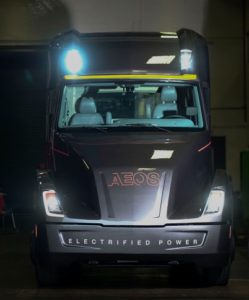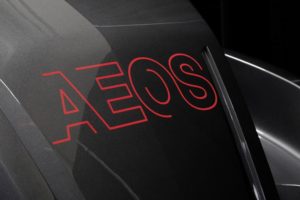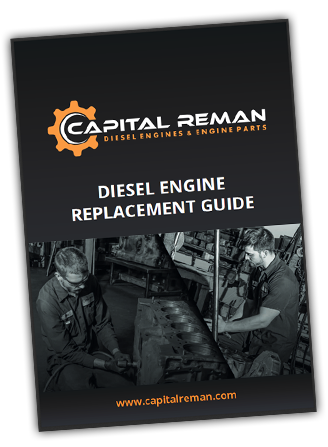Cummins Looks to the Future: Unveiling First Electric Powered Semi
 Legendary diesel engine manufacturer, Cummins Inc., has unveiled a revolutionary electric powered semi-truck prototype. The declaration comes just weeks before Tesla’s anticipated announcement of their own electric tractor trailer. The Cummins electric semi-truck will be regarded as a Class 7 Heavy Duty Truck Cab with 140 kWh battery pack.
Legendary diesel engine manufacturer, Cummins Inc., has unveiled a revolutionary electric powered semi-truck prototype. The declaration comes just weeks before Tesla’s anticipated announcement of their own electric tractor trailer. The Cummins electric semi-truck will be regarded as a Class 7 Heavy Duty Truck Cab with 140 kWh battery pack.
Cummins does not plan to get into the semi truck manufacturing market but rather sell their heavy duty electric engine to commercial fleets and municipal government markets. The new engine system is known as the AEOS Engine, named after Greek mythological hero, Helio’s favorite horse. The 18,000 lbs., AEOS Tractor Trailer is rated to haul a 22 ton load and will be fully available starting in 2019.
The new AEOS engine is designed for cartage transportation and has a 100 mile operating range. Cartage trucking mostly specializes in the distribution of freight in a radius around major metropolitan areas or shipping ports. Examples of Class 7 Trucks would be food or package delivery vehicles ie.. (UPS or Bread Trucks.)
The new engine is not suited for long-haul trucking due to its short battery life. The Cummins Semi-Truck will need to be re-charged after 100 miles and take 1 hour at any 140 kWh charging station. Cummins hopes to get the charging time down to 20 minutes by 2020. Also in 2020 Cummins will have an extended version available with a small diesel engine which will act as an on-board generator for the batteries. The new low emissions diesel hybrid will be able to go 300 miles between charges and offer 50% fuel savings compared to the diesel hybrids on the market today. The company is researching the viability of adding solar powers to the top of the truck to further produce energy on the fly.
Planning for the Future of Heavy Duty Engine Production
Cummins is planning for the future of on-road trucking whatever that might be. Upper management at Cummins has always been forward thinking. Cummins CEO, Thomas Linebarger said, “There are more technologies coming into economic relevance than we've seen in my career, ever. This is what we do. We feel we do better when technologies are shifting.” Photo Credit Cummins, Inc.®
Photo Credit Cummins, Inc.®
The company, first started by Clessie Cummins in 1919, has seen many changes throughout its 98 year history. Over the years the organization has overcome many roadblocks to success in its journey. The company embraced the shift from 2-Stroke to 4-Stroke diesel engines instead of going under. In recent years the industry leader has been a pioneer in environmental issues and diesel particulate after-treatment systems for all of its engines. Rival Caterpillar Inc. decided to exit the over-the-road trucking industry in 2010 after failing to adapt to changing emissions regulations.
Cummins enters an already crowded electric / self driving vehicle market dominated by Bosch, Google, Daimler, Tesla and dozens of others. Much like the large auto and diesel competition, Cummins has been working on this technology for around a decade now. Cummins believes its experience in the trucking industry gives it an edge over newer startups like Tesla.
Tesla however is banking that its propriety batteries will be considered as the “gold standard” in the electric engine industry. Tesla makes its own batteries at its gigantic factory in the Nevada desert. Elon Musk wants to be in the battery business and license or sell the technology to all other electric engine manufacturers for years to come. Still there is a steep learning curve in the trucking industry.
What Tesla and upstarts like Google lack is the knowledge of the trucking customer base. Linebarger stated, “Where Cummins has an edge, is in understanding our customer’s needs. We know that we cannot have one solution for everybody which is why Cummins will continue to provide a variety of power technologies -- including electric, diesel, natural gas and future alternative fuels -- for different applications. We need to make sure we have the right technology for the right application. Even if the electrified power train replaces the internal combustion engine completely, that's still a 20- to 25-year transition period customers have to manage through. If we have good technology, they'll want to buy it from us."
Drawbacks of Current Electric Engines
Still the technology is in its infancy. A Class 8 electronic truck engine does not make practical sense at this time. An all-electric powertrain with current battery power technology does not meet the demands of the long-haul trucking industry. Batteries will only go 200-300 miles before needing to recharge. Even 20 minute recharging times are much too long for truck drivers on tight delivery schedules. A Cummins ISX diesel engine will go about 6 MPG and typically carry twin 150 gallon tanks. That means a Cummins diesel powered semi could go 1,800 miles without having to stop and fill up. If a long-haul trucker relied only on a pure battery powered vehicle they would have to stop every 2-3 hours to recharge vs. every 2-3 days running pure diesel. Factor in the current 1 hour re-charge time and lack of charging stations and you have a system that just doesn’t work. Electric engine technology is still unproven with regards to nominal torque rating, handing up steep grades, pulling large loads, operating in the cold and on the fly repair needs. Photo Credit Cummins, Inc.®
Photo Credit Cummins, Inc.®
There are many companies out there trying to improve the battery life and safety of the lithium ion battery technology which has not essentially changed since its inception in the early 1970s. Over a battery’s lifespan the unit degrades increasingly over time with a rapid reduction in charge capacity, cycle life (full recharge) and stability due to chemical changes to the electrodes in the battery. A 2015 study done by the Karlsruhe Institute of Technology found the battery life of a lithium ion battery varies greatly with 30% loss of charge after 3000 full recharge cycles for some units and 5000 full recharge cycles for others. The study also found that safety standards for some batteries were not consistent and that for large stationary batteries to be profitable that at least 3000 recharge cycles needed to be met. Still scientists are working hard to solve the battery life issue. Companies like Siemens are field testing eHighways which would consist of overhead wires to charge onboard batteries. The 150 year old technology, which was used to power electric trains and street cars, could get a new lease on life. The company stated that building out an overhead wire infrastructure could save $227 billion over the cost of producing more powerful hydrogen fuel cell technology.
Only time will tell what the future may hold for the electric engine in the over-the-road trucking industry. With the advent of change it forces a premium on faster pace adaption. Innovation and advancement are built on the rapid need to adapt to survive. Cummins seems to not only understand this concept but embrace it. Eventually, one of these newer companies will figure out a long lasting battery to harness great amounts of energy in a compact space. As technology progresses it will be up to the manufacturers, companies and ultimately the drivers to keep up with the changes. Those who do not adapt will go the way of the dinosaurs. Greek philosopher Heraclitus said it best, “All is flux, nothing stays still – there is nothing permanent except change.”




